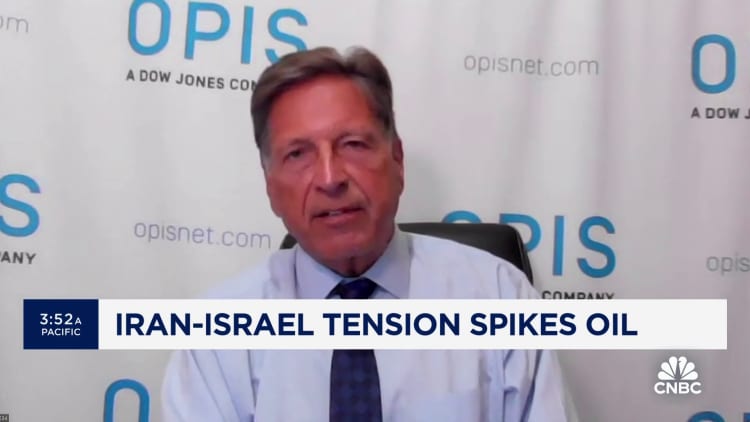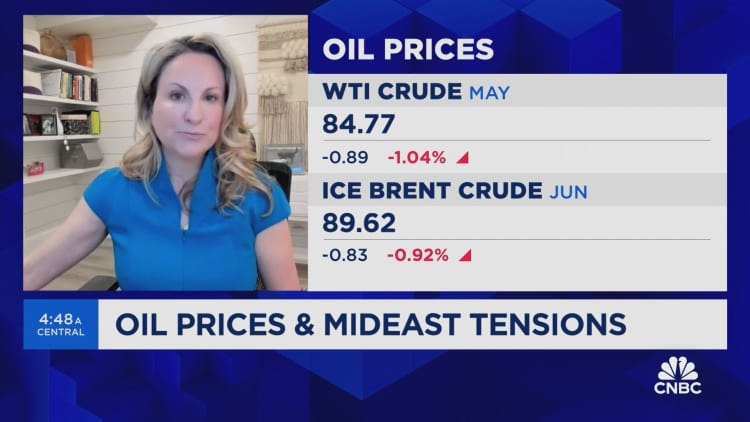- Markets saw limited movement Monday, but all eyes are on Israel’s next steps after an Iranian drone and missile strike on Saturday.
- The U.S. dollar and oil prices retreated from Friday gains driven by speculation of the coming strike.
- Long-term risk premia have increased, analysts and economists said, particularly if the oil market is significantly impacted.
Markets kept their cool on Monday amid a fast-moving and volatile geopolitical landscape in the Middle East — but the longer-term risk premium has likely risen, while oil prices remain on edge, analysts said.
Iran launched more than 300 drones and missiles against military targets in Israel on Saturday, marking the first direct attack on the Jewish state from Iranian territory. The offensive caused limited damage and no fatalities.
Iran said it was acting in self-defense in response to a strike on its diplomatic compound in Damascus, Syria, earlier this month. Israel has declined to comment on its involvement.
Also on Saturday, ahead of the strike, Iran seized a container ship in the Strait of Hormuz that Tehran said was linked to Israel. The sea passage is described as the “world’s most important oil chokepoint,” with flows totalling around 21% of global petroleum liquids consumption in 2022, according to the U.S. Energy Information Administration.
By Monday, global players including the U.S. and European leaders were seeking to cool tensions, urging Israel to show restraint in its response.
Foreign exchange markets are pricing in “near term de-escalation” in the wake of the weekend events, Adarsh Sinha, co-head of Asia FX and rates strategy at Bank of America, told CNBC’s “Squawk Box Europe” on Monday. The ‘safe haven’ U.S. dollar was 0.15% lower against a basket of major currencies early Monday, also weakening against the Iranian rial and the Israeli shekel.
Sinha nevertheless added that “the fact that we moved from a proxy confrontation to a direct confrontation, even though that de-escalates in the near term, the longer term risk premium probably goes up.”
“I think the FX market ultimately will take its cue from oil prices because ultimately, that’s the channel through which it spills over to the FX market,” he said.

Oil prices were lower in early Asia hours on Monday, cooling off from Friday gains which built on the expectation of an Iranian strike. Nymex WTI crude futures contracts with May expiry were 0.81% lower at $84.97 per barrel by early afternoon in London, while the ICE Brent contract with June delivery was down 0.73% at $89.79 per barrel.
Markets had priced in the “well-telegraphed” event, which explains the price decline, Amrita Sen, founder of Energy Aspects, told CNBC’s “Street Signs Europe.”
That doesn’t mean prices will continued to go down, she added — although their course will hinge on Israel’s reaction and next steps.
Risks increased
Economists and analysts agreed that overall long-term risks and uncertainty are now heightened.
“The unprecedented Iranian attack on Israeli targets casts a shadow over the economic and financial outlook beyond the region itself. The risk that the conflict in the Middle East may escalate further has increased,” Holger Schmieding, chief economist at Berenberg Bank, said in a Monday note.
Conflict between Israel and Iran is unlikely to have a severe impact on the global economy, Schmieding continued, pointing to the relatively limited effect to the economic outlook caused by Houthi attacks on cargo ships in the Red Sea.

Disruption to oil shipments through the Strait of Hormuz “would be a very different matter,” he said, calling this the “key risk to watch.” However, this hit to oil exports would hurt Iran badly, Schmieding continued, meaning that Tehran is unlikely to want to escalate to such a level.
A possible Iranian blockade of the Strait of Hormuz will hold Brent prices above $84 dollars per barrel for the remainder of the year and cause a potential rally to over $100 per barrel in the event of “open war,” according to Bartosz Sawicki, market analyst at Conotoxia.
Iran’s assault has already threatened regional oil supply in a market that has been “broadly balanced” in the first part of the year, and increased the risk of flipping to undersupply, Sawicki said. Iran’s crude production totals nearly 3.5 million barrels per day, accounting for around 3.3% of global production, he noted.
“A tougher stance on Iran and stricter enforcement of previous sanctions should be expected,” Sawicki, said. Significant retaliation by Israel could meanwhile trigger an oil price rally, strong demand for the U.S. dollar and renewed buying of gold, he added.
European equity markets were slightly higher Monday, with U.S. futures also brightening from a Friday retreat.
Impact on stocks could come by way of a change to interest rate expectations, analysts at Deutsche Bank said in a note.
Yet what form that will take is uncertain, they add. Higher oil prices could keep inflation sticky in major economies, pushing back the timing of interest rate cuts — while a “geopolitical shock” could bring such trims forward by threatening growth.












